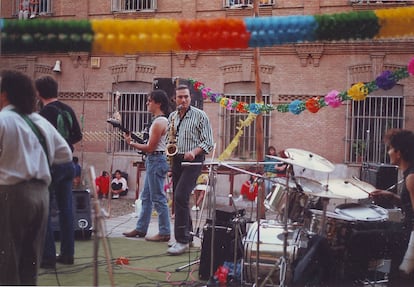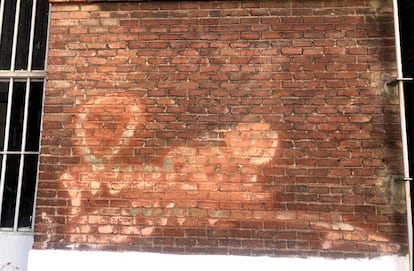If the famous Madrid Movida of the eighties had had a logo, it would undoubtedly have been the word “Muelle” underlined by a spiral ending in an arrow. It was the peculiar signature turned into a work of art by Juan Carlos Argüello Garzo (1965-1995), the pioneer of graffiti in Spain, who captured it in the most unexpected corners of a capital then in full cultural ferment. Today, with just over a year left until the 30th anniversary of Argüello’s death from cancer, his legacy has practically disappeared from the place for which it was intended: the walls of the streets. With some exceptions, such as the central Montera street in Madrid, there are almost no places left to see that iconic signature. Therefore, the discovery of one of these graffiti is a cultural event… especially when it occurs in a place as unexpected as the inside of a prison.
The prison where it occurred is the old Yeserías women’s prison, a neo-Mudejar style building located in the center of Madrid that was built in the 1920s and which currently continues to house inmates after being converted into the Insertion Center. Social (CIS) Victoria Kent. There, dozens of inmates serve their sentences in semi-freedom, including some of the main prisoners convicted by the Gürtel case of corruption, such as Luis Bárcenas and Francisco Correa. On an interior brick wall, between a barred door and window that give access to the area that now serves as a historical archive of the files of prisoners from the penitentiary centers that Madrid has had, the remains of graffiti are visible that, At the time, it tried to be erased and that, although it has lost most of its original colors – green and orange -, Muelle’s peculiar style is still perfectly distinguishable, according to the photographs to which EL has had access. COUNTRY.
The discovery was almost accidental. A monitor who gives painting training courses to inmates in Madrid and who had an old photograph of that graffiti for eight years heard about it still existing. He mentioned it in the first months of this year to both Penitentiary Institutions and Francisco Reyes, professor of the Department of Applied Communication Sciences at the Complutense University and expert in urban art. The Ministry of the Interior authorized entry into the prison facility, on April 24, to corroborate that that signature was from the Madrid graffiti artist, Reyes himself, and also university professor Alberto Mingote – both of whom are preparing a large exhibition on Muelle for the end of this year. year in Madrid― and Fernando Argüello, the artist’s brother who manages the website and social media profiles that keep his cultural legacy alive.

As the three agreed to state to this newspaper in a telephone conversation, there is “no doubt” that the signature is the work of Juan Carlos Argüello. The photograph that led to the discovery, taken in the spring of 1991, more than 30 years ago, corroborates this. In that image you can see a group of inmates posing under the graffiti. “The visit has allowed us to confirm that this work existed and, most importantly, that there is still a trace of it,” highlights Reyes.
The question that arises now is whether it can be restored and how. “Someone tried to erase it with an iron barbed brush and it is in pretty bad condition,” laments Mingote. The next step is the preparation of a report by Reyes and Mingote to be delivered to the Heritage of the Community of Madrid, which will decide if and which measures are taken to preserve the graffiti. Penitentiary Institutions has assured this newspaper that it will make every effort to preserve it if it is finally decided to do so.
How Muelle’s signature reached that interior wall of a prison that was theoretically inaccessible to someone from the outside is related to another of Argüello’s artistic skills: music. Pier played drums on Panic on the Phone, one of the rock groups that won a rock demo contest called Circuitos in August 1990, which was organized by the Community of Madrid. The prize included performing in the following months in different locations in Madrid, but also in the Yeserías prison. They went there in the spring of 1991. “Two days before the concert, (Argüello) had an accident and his left arm was put in a cast. Despite this, he said that he did not miss it and went to play,” recalls Javier Escudero, singer and guitarist of Panic on the Phone and who currently continues to be linked to music with the project Scud Hero.
Escudero remembers that Muelle always went “with the drumsticks and the sprays of paint” and that that day someone – “maybe the members of the group, I don’t remember” – told someone in charge of the prison that the then-famous author of the graffiti was the drummer. “They asked him to paint on a wall and he did it. The rest of the group had to wait a while for him to leave. I never saw what he had done,” recalls the musician.

Jesús Pardo, a music producer who organized that demo contest and who accompanied the group to prison that day, also remembers that concert. “Argüello was especially brilliant on the drums. For me he was a much better musician than a gratifer,” he highlights. Prado assures that he was never aware that that day Muelle painted one of his famous signatures on the walls of the prison, but he does remember the atmosphere in which the concert took place: “It was a women-only prison and you could see the anxious prisoners, expectant to hear the concert. I understand that for them it was a bit of fresh air in their confinement.”
There is a photo of that concert, in which Muelle is only partially seen on the drums with his left arm in a cast and the rest of the group’s members, almost all of them with their backs turned. On the stage, multicolored garlands and, in the background, several inmates sitting on the floor of the patio leaning on the wall of the building and others leaning out of the barred windows of the first floor while attending the performance. From that day, in addition to those walls, Muelle’s signature still remains.

